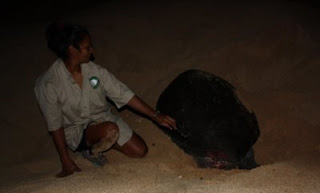Ascension Island – Turtle Watching
The turtle watching began at the Conservation building in the centre of town where we watched a short video on the turtles of Ascension. Then we headed out to the beach I’d been on just a few hours before. The group walked along the track at the back of the beach while two people from Conservation walked around the beach turtle-spotting. They don’t come onto shore until quite late (at least 10 pm) so we had to wait a while before we got the word that one had been found laying. We were told not to approach the turtles coming up the beach but once they begin laying nothing will distract them. We walked towards the shore and there in a huge crater, at least 3 metres across, was a green turtle.
 This turtle was about average size, with a carapace of about 1 metre in length. She was busy laying her eggs and you could actually see them coming out from the cloaca below the tail.
This turtle was about average size, with a carapace of about 1 metre in length. She was busy laying her eggs and you could actually see them coming out from the cloaca below the tail.

Females travel from the Brazilian coast every three or four years to mate and lay eggs on Ascension. They take so long between breeding periods because there is no food for them around the island so they spend up to six months without feeding, and recovering from this takes a long time. They come to shore to lay about 6 times during the season, which lasts from December to June (if I remember correctly) and peaks in March. Eggs in a single clutch can be fertilised by more than one male. The sex is determined by the temperature, with males being produced when the temperature falls below 29ºC and females when the temperature remains above.
I feel privileged to have been able to see a turtle laying. When I was a kid I almost got to see a loggerhead turtle lay but it was scared off before it was able to. I studied these turtles at Auckland as an example of long-distance migration and it’s always been my hope I’d get to see them in the flesh. I can definitely say I have done now!
 This turtle was about average size, with a carapace of about 1 metre in length. She was busy laying her eggs and you could actually see them coming out from the cloaca below the tail.
This turtle was about average size, with a carapace of about 1 metre in length. She was busy laying her eggs and you could actually see them coming out from the cloaca below the tail.
Females travel from the Brazilian coast every three or four years to mate and lay eggs on Ascension. They take so long between breeding periods because there is no food for them around the island so they spend up to six months without feeding, and recovering from this takes a long time. They come to shore to lay about 6 times during the season, which lasts from December to June (if I remember correctly) and peaks in March. Eggs in a single clutch can be fertilised by more than one male. The sex is determined by the temperature, with males being produced when the temperature falls below 29ºC and females when the temperature remains above.
Seeing the turtle up close was incredible. The tail was really dextrous and carefully moved around the clutch as she laid. When laying was completed she used her back flippers to carefully cover the eggs with sand, pulling sand in from surprisingly far in front of the clutch. Once a mound sufficiently high had been produced she used her front flippers to cover the area with a large amount of sand in order to disguise the area. At this point, with sand flying everywhere, we left her to it. It can take well over an hour for them to dig the crater and about the same amount of time to camouflage it. Laying is therefore an arduous, energetically-demanding feat and it’s no surprise they only do it every few years. Turtles have laid on this beach, and others around the island pretty much since the beaches came into existence and they are likely to continue doing so until the island erodes away. The population is stable and there are few local threats to them (although what happens to them at sea is a different matter).
I feel privileged to have been able to see a turtle laying. When I was a kid I almost got to see a loggerhead turtle lay but it was scared off before it was able to. I studied these turtles at Auckland as an example of long-distance migration and it’s always been my hope I’d get to see them in the flesh. I can definitely say I have done now!


Comments